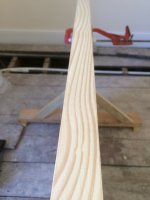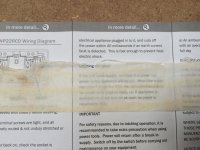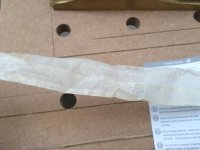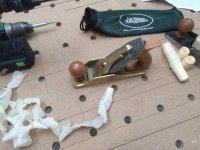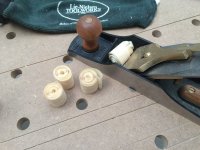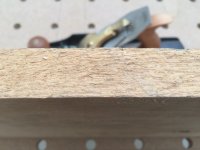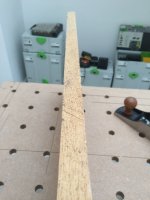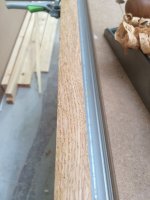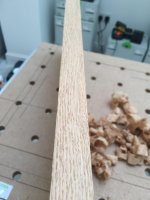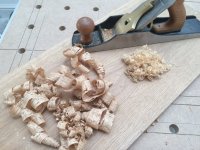Edward, take a long weekend and drive to Rockland, Me area (about 6 hours from NYC) to visit Lie Nielsen. Better yet, take one of the weekend workshops where you will likely interact with the owner and his family. Used to live in Maine and visit there often. And as if a relaxing weekend in Maine with tools isn't enough, they offer a discount in the showroom (used to be the policy, call ahead to verify)
You are using an out of date browser. It may not display this or other websites correctly.
You should upgrade or use an alternative browser.
You should upgrade or use an alternative browser.
Hand plane 101
- Thread starter ear3
- Start date
ear3
Member
Ended up going with the Lie Nielsen.
Edward A Reno III said:Ended up going with the Lie Nielsen.
Congratulations. Great choice. I think you'll enjoy using it for many years to come
ear3
Member
Thanks. Not that I have anything against Canadians -- in face, those are my roots, as my Great-Grandfather's name was changed from Renaud to Reno when he crossed over from Quebec in the early 20th century -- but all things being equal the deciding factor was actually buying American. I figure enough of my dollars already go to support the international economy through my Green tool purchases.
jbasen said:Edward A Reno III said:Ended up going with the Lie Nielsen.
Congratulations. Great choice. I think you'll enjoy using it for many years to come
nclemmons
Member
LN is a great choice. You go with the #62 and a coupe of extra blades?
AndyUK said:danbox said:All my hand planes lie Nielsen, and I have a lot. which is a shame as I'm from the UK, but unfortunately Stanley are not what they used to be. They are very good and well worth the money, if you look after them properly they will be good enough to last a few life times.
If you are going to buy some vintage planes to refurbish take a piece of plate glass with you, lay the plane flat on the glass and try to slide a piece of Paper under each corner, if it slides under any corner just discard it and move on, it will be to much work to try and get the sole flat. It doesn't matter if the base is concave as this will not effect the performance of the plane but the edges must be flat. If it's cheap you could buy it for the hardware.
The low angle jack plane is most commonly for end grain if this wasn't mentioned above.
Wouldn't it be easier just to use a steel rule and look up to the light for checking flatness of the sole?
No.
AndyUK
Member
- Joined
- Dec 31, 2015
- Messages
- 58
danbox said:AndyUK said:danbox said:All my hand planes lie Nielsen, and I have a lot. which is a shame as I'm from the UK, but unfortunately Stanley are not what they used to be. They are very good and well worth the money, if you look after them properly they will be good enough to last a few life times.
If you are going to buy some vintage planes to refurbish take a piece of plate glass with you, lay the plane flat on the glass and try to slide a piece of Paper under each corner, if it slides under any corner just discard it and move on, it will be to much work to try and get the sole flat. It doesn't matter if the base is concave as this will not effect the performance of the plane but the edges must be flat. If it's cheap you could buy it for the hardware.
The low angle jack plane is most commonly for end grain if this wasn't mentioned above.
Wouldn't it be easier just to use a steel rule and look up to the light for checking flatness of the sole?
No.
So how would a young chap such as Edward wander nonchalantly around the flea markets and vintage stores in search of a quality secondhand bench plane with a large piece of plate glass upon his person?
Would a steel rule or even a metal square not be more discreet for this purpose? [big grin]
ear3
Member
[member=167]neilc[/member] Yup.
neilc said:LN is a great choice. You go with the #62 and a coupe of extra blades?
How big the plane he wants to buy? You only need a piece a lapping glass, you can get a bit of float glass about 12" by 4", I put mine in the missus's handbag.AndyUK said:danbox said:AndyUK said:danbox said:All my hand planes lie Nielsen, and I have a lot. which is a shame as I'm from the UK, but unfortunately Stanley are not what they used to be. They are very good and well worth the money, if you look after them properly they will be good enough to last a few life times.
If you are going to buy some vintage planes to refurbish take a piece of plate glass with you, lay the plane flat on the glass and try to slide a piece of Paper under each corner, if it slides under any corner just discard it and move on, it will be to much work to try and get the sole flat. It doesn't matter if the base is concave as this will not effect the performance of the plane but the edges must be flat. If it's cheap you could buy it for the hardware.
The low angle jack plane is most commonly for end grain if this wasn't mentioned above.
Wouldn't it be easier just to use a steel rule and look up to the light for checking flatness of the sole?
No.
So how would a young chap such as Edward wander nonchalantly around the flea markets and vintage stores in search of a quality secondhand bench plane with a large piece of plate glass upon his person?
Would a steel rule or even a metal square not be more discreet for this purpose? [big grin]
With a flat rule you wont be able to tell if the plane sits flat, if your looking top down onto the plane the left and right side of the plane may be dead true with a steel rule but how would you tell if it was true front to back, you could put an engineers square on the side of the plane front and back but this wouldnt tell you if the plane is twisted or warped.
If you are going to buy a second hand plane you need to ensure the sole is flat if you want it to perform correctly, you will need to work it the same as you do the back of your chisels(Lapping) its much easier to have something with you that is guaranteed flat that you can just lay the plane on to.
AndyUK
Member
- Joined
- Dec 31, 2015
- Messages
- 58
I'm not being pedantic here Danbox but I don't buy your theory that plate glass and attempting to slide a piece of paper into each corner is the comprehensive way to check a plane sole. Yes It would pick up on one or more of the corners not being flat but it wouldn't pick up wear down the centre of a plane sole that had been worn due to excessive edge jointing. Would it?
I went and hung a few doors this morning before the Grand Prix started.
I used a 5 1/2 Jack plane to shoot the edges in, the shavings just rolled off in one piece.
View attachment 1
View attachment 2
View attachment 3
I then just used a No 4 Smoothing plane to finish the edge, the shavings from this plane are so fine...
View attachment 4
View attachment 5
View attachment 6
I also have plane socks for ones i use on site to offer some protection, they also have other uses to....
View attachment 7
I used a 5 1/2 Jack plane to shoot the edges in, the shavings just rolled off in one piece.
View attachment 1
View attachment 2
View attachment 3
I then just used a No 4 Smoothing plane to finish the edge, the shavings from this plane are so fine...
View attachment 4
View attachment 5
View attachment 6
I also have plane socks for ones i use on site to offer some protection, they also have other uses to....
View attachment 7
Attachments
AndyUK said:I'm not being pedantic here Danbox but I don't buy your theory that plate glass and attempting to slide a piece of paper into each corner is the comprehensive way to check a plane sole. Yes It would pick up on one or more of the corners not being flat but it wouldn't pick up wear down the centre of a plane sole that had been worn due to excessive edge jointing. Would it?
Well this is how Paul Sellers taught me to check a plane many years ago so i'll stick with it. It might even be in one of his videos so I'll have a check and get back to you.
WarnerConstCo.
Member
- Joined
- Apr 14, 2008
- Messages
- 4,205
I have accumulated a nice selection of old bailey and Stanley planes.
It doesn't take much effort to flatten the soles, flatten the back of the iron and get to making shavings.
All I use is a small granite surface plate, some wet sandpaper and some high spot blue.
It doesn't take much effort to flatten the soles, flatten the back of the iron and get to making shavings.
All I use is a small granite surface plate, some wet sandpaper and some high spot blue.
ear3
Member
Based on those images, tt looks like the smoothing plane is not far off for me [member=59697]danbox[/member] . Question: is it relatively easy to keep a 90 degree angle when shooting those long edges with the jack plane? One of the things I want to use it for is to make a glue ready joint when I'm edge joining thicker pieces in a butcher block type application. I still occasionally get saw marks when I rip things 6/4 and above on the table saw, and I don't have a jointer. Or is it better to have a jointer plane for this?
danbox said:I went and hung a few doors this morning before the Grand Prix started.
I used a 5 1/2 Jack plane to shoot the edges in, the shavings just rolled off in one piece.
View attachment 1
View attachment 2
View attachment 3
I then just used a No 4 Smoothing plane to finish the edge, the shavings from this plane are so fine...
View attachment 4
View attachment 5
View attachment 6
I also have plane socks for ones i use on site to offer some protection, they also have other uses to....
View attachment 7
rvieceli
Member
Here you go:
http://www.leevalley.com/US/wood/page.aspx?p=41716&cat=1,41182
http://www.leevalley.com/US/wood/page.aspx?p=41716&cat=1,41182
Edward A Reno III said:Based on those images, tt looks like the smoothing plane is not far off for me [member=59697]danbox[/member] . Question: is it relatively easy to keep a 90 degree angle when shooting those long edges with the jack plane? One of the things I want to use it for is to make a glue ready joint when I'm edge joining thicker pieces in a butcher block type application. I still occasionally get saw marks when I rip things 6/4 and above on the table saw, and I don't have a jointer. Or is it better to have a jointer plane for this?
danbox said:I went and hung a few doors this morning before the Grand Prix started.
I used a 5 1/2 Jack plane to shoot the edges in, the shavings just rolled off in one piece.
View attachment 1
View attachment 2
View attachment 3
I then just used a No 4 Smoothing plane to finish the edge, the shavings from this plane are so fine...
View attachment 4
View attachment 5
View attachment 6
I also have plane socks for ones i use on site to offer some protection, they also have other uses to....
View attachment 7
If you've cut the board on the table saw then I presume that the edge is already at 90 degree's and you just want to have the edge ready for glue up. The Jack plane is fine for this, I saw you post just as I was tiding up, I had a piece of oak that had a sawn edge on it so I ran the 5 1/2 jack plane over it to show you.
View attachment 1
View attachment 2
View attachment 3
I ran over the edge about 4 to 5 times to this
View attachment 4
Then a couple more, I backed the blade off just a touch for some finer shavings and the edge now look like this, it's so smooth.
View attachment 5
View attachment 6
I'd happily recommend this as your first plane as its a great all rounder, I don't know if you know who Paul Seller's is but I see he now has quite a few video's on youtube so they are defiantly worth watching if your just getting into hand tools and want to learn more about the different types of hand planes.
I can plane a board by hand to 90 degree without a guide quite well but this is just from practice, I do however have a set of bronze Lie Nielsen edge planes if I need to ensure total accuracy, or an adapter like to one above will work fine.
Attachments
Cheese
Member
rvieceli said:Here you go:
http://www.leevalley.com/US/wood/page.aspx?p=41716&cat=1,41182
Thanks for the post Ron, I didn't know that item existed.
Similar threads
- Replies
- 2
- Views
- 671
- Replies
- 16
- Views
- 900
- Replies
- 13
- Views
- 589

